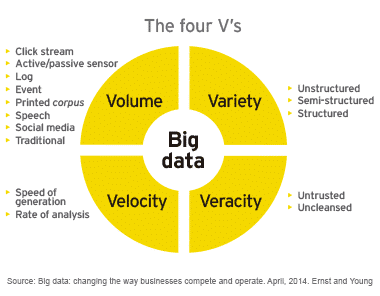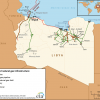
Immense amounts of data, from a wide variety of sources, are becoming available at an incredible speed. But what is the link between climate change and Big Data? The Ramón Areces Foundation recently hosted a meeting on this topic. During the meeting we were told that climate change mitigation and adaptation are already benefitting from the use of Big Data and that other areas of climate action could benefit from the data revolution in the future.
According to Gartner, Big Data is ‘high-volume, high-velocity and/or high-variety information assets that demand cost-effective, innovative forms of information processing that enable enhanced insight, decision making, and process automation’. In short, Big Data entails the management of large amounts of data and the use of tools and processes that enable the discovery of patterns that allow predictive models to emerge[1].
A simplified description of the process by which raw and heterogeneous data is converted into knowledge is as follows: data from a wide array of sources is stored in a database server. Data is then cleaned and integrated in order to allow the process of data selection and transformation to take place. Analysing the selected data and evaluating patterns culminate in the generation of actionable knowledge.
IBM, among others[2], characterises the dimensions of Big Data (see figure 1 below) as including:
- Volume. The amount of data produced is so large that new analytical tools are required to undertake analyses. In fact so much data is produced that 90% of the data in the world has been produced in the last two years. In studying climate change, Big Data is allowing for the analysis of a larger array of phenomena, with higher resolution levels and a larger number of variables.
- Variety. Data is produced in different forms (structured, semi-structured and unstructured). For instance, temperature data, geographical data, aggregated and anonymous bank transactions, mobile phone data and social network data can, when combined, provide information to analyse extreme weather events and the social response to these.
- Velocity. The speed at which information is produced has grown exponentially.
- Veracity refers to the current uncertainty of data, issues of data accuracy and credibility.

As it is applied to climate change, the Big Data process described above is enabling better monitoring, characterising and modelling of climate data. For instance, according to Doblas-Reyes et al. (2015) initiatives such as the Coupled Model Intercomparison Project (CMIP) seek to develop a state of the art climate information system that will provide knowledge that can aid in the implementation of mitigation and adaptation efforts enshrined in international climate agreements.
Other examples of the use of Big Data in the field of climate change include better monitoring of land use change through initiatives such as Global Forest Watch. In Sumatra, this initiative has allowed to reduce response time from 36 hours to 4 hours using satellite images of forest fires according to Miguel Luengo-Oroz, Chief data scientist at UN Global Pulse. The transport and energy sectors, key sources of greenhouse gas emissions, are also benefitting from Big Data. Transport trajectories and energy use can potentially be optimised through the installation of sensors in vehicles and smart metering in houses. In the area of built environments the project ‘‘SmartSpaces” by Bristol City Energy Services measures temperature in public buildings such as schools so that heating can be optimally programmed, saving energy. In the agricultural sector projects using Big Data such as Climate Smart Agriculture, developed at the International Centre for tropical Agriculture (CIAT), have produced farming recommendations for rice growers thus reducing vulnerability to climate variability (for other initiatives please see the UN Big Data Climate Challenge).
Within the realm of behavioural change and social reactions, apps that tell drivers their GHG emissions per trip or air quality sensors installed on bicycles are expected to nudge individuals towards lower emission behaviours. Furthermore, social reactions to extreme weather events (EWE) such as floods can be better understood through the use of georeferenced data from anonymised twitter messages or phone calls, which enable issuing early warnings and help direct response measures towards areas where it is most needed.
The above examples are mainly focused on mitigation and adaptation but there is scope for further use of Big Data in the field of monitoring, reporting and verification, all key in the implementation of the Paris Climate Change Agreement.
The above applications of Big Data as well as future developments are however challenged by several issues:
- Ensuring data quality and integrity by internally checking information and conducting external audits. The main goal being sound decision-making.
- Data rights. Related to Human rights is the need to include all individuals in statistics to avoid invisibility, especially of the poorest and most vulnerable.
- Data timeliness. The timely release of data is essential in ensuring prompt response to events.
- Transparency, openness and usability. Data as a public good. Enabling Big Data to become available to all in a user-friendly manner.
- Data ethics. Data protection and privacy standards and rules are needed in order to ensure information is not used against individuals.
- Data independence. There is a need to ensure information gathering and analysis is shielded from regulatory capture and lobbying.
Issues of funding, sovereignty, motivation for information sharing by individuals and companies, national security and competitiveness concerns may hinder the widespread Big Data revolution that is being called for by international institutions. Working on the aforementioned challenges and a forward looking data agenda for climate change, and sustainable development more broadly, could however provide a much needed push towards monitoring, accountability and action in future rounds of climate negotiations.
[1] Belda, F. (2015), Big Data y servicios climáticos: un caso de estudio. Revista de Ciencias y Humanidades. Fundación Ramón Areces. Nº14: 118-122.
[2] Note that there are other, broader, conceptualisations of Big Data. See for example: Latouzé, E. (2015), Big Data & Mobility. World Bank Premier Series.


